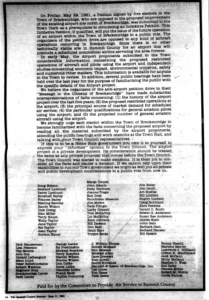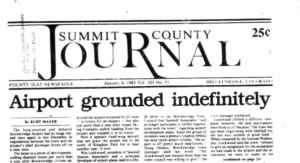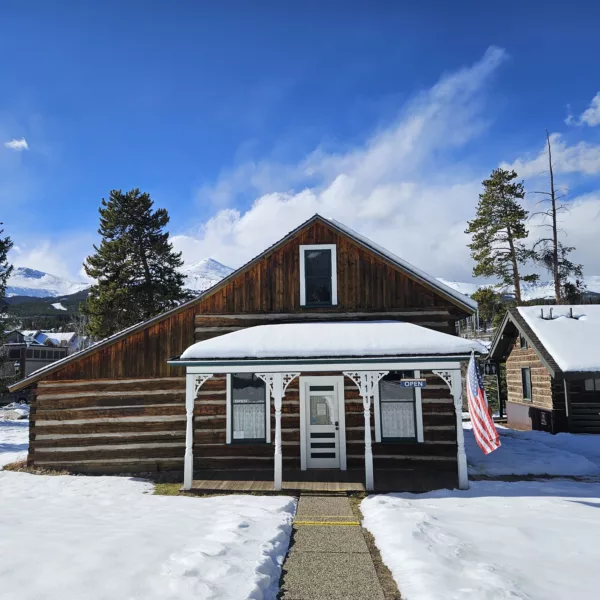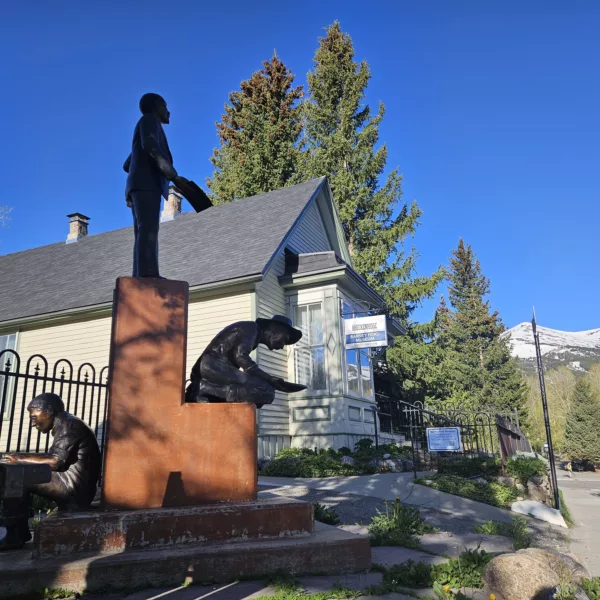Breckenridge’s Airport Legacy: Part 2
March 22, 2023 | Category: Our Collective History

A de Havilland DHC-6 Twin Otter plane in mid-air. These planes are still in production through Viking Air. Courtesy Viking Air Ltd.
Breckenridge’s Airport Road remains the sole legacy of the history of airplanes and wished-for airport development in town. From the beginning of Breckenridge as a ski town, airplanes played an important role in the community’s growth. And while many residents hoped that a bona fide airport would cover the rockpiles in the valley, it never came to fruition. In this second article on Breckenridge’s airport, learn more about the legacy of Airport Road.
In Breckenridge’s Airport Legacy: Part 1, Breckenridge History shared the link between airplanes and our town’s development as a ski destination. As early as 1960, the first investors, the Rounds family, flew into Breckenridge, landing at a rough strip north of Tiger Road. With the construction of a longer landing strip in the valley floor, private pilots flew into Breckenridge for many years. Even the purchase of the ski area by Aspen Ski Corporation in 1970 connects to air flight into the valley. Still today, residents remember a 1977 plane crash carrying members of a band who had just played at Shamus O’Toole’s Roadhouse Saloon.
Talk of Commercial Airport Buzzed Around Town
By the late 1970s, talk of a commercial airport in Breckenridge buzzed around town. A headline in the Summit County Journal in January 1976 asked: “Summit International Airport?” After initial intentions to develop an airport for private and charter flights, the conversation soon shifted to a full-service airport with regularly scheduled passenger aircraft
Breckenridge Lands, Inc. (BLI), the successor entity to the Rounds’ family business ventures, wanted to donate the land for the airport development. John Rahm, then head of the Breckenridge Ski Corporation, supported the effort, saying “there will be an airport in Summit County, in the future.”
By spring, the Town appointed an airport study group comprised of Win Lockwood, Jeff Paffrath, Jerry Cooney, and Bob Maynard, CEO of Keystone. Spring is also election season for Breckenridge Town Council and the “Bullish on Breckenridge” candidates, a pro-airport and pro-development slate, prevailed in the polls.
The study group kept their work quiet for several years until local residents were surprised in November 1978 with the headline: “Commercial Air Service Set to Begin in November 1979.” This time, Summit County Government took the lead, reaching a tentative agreement with Rocky Mountain Airways and the Breckenridge Economic Development Commission (BEDC) to construct and maintain a STOLport (short take-off and landing). DeHaviland Twin Otters holding 19 passengers and Dash-7s carrying up to 49 passengers would be the aircraft of choice.
The agreement covered construction and paving of an 8000’ runway, maintenance, a microwave landing system, runway lights, terminal building and ground transportation. To meet FAA requirements for aviation, a 261’ tall tower would be erected.
Anticipating opposition, Win Lockwood of the BEDC said that the DeHaviland STOLcrafts were “among the safest planes today.” Within a few years after completion, Lockwood anticipated that the airport would see 10 flights a day utilizing the Twin Otters, and during peak ski season, twenty flights a day with the Dash-7s.
More Influential Visitors
Lockwood and other proponents of the airport touted it as an economic benefit. The group’s summary stated: “Establishment of airline service will serve to make Summit County more competitive with other resort areas and will attract more influential visitors to the area.”
Within weeks, the opposition organized. Surprised by the sudden announcement of a coming airport, a group calling themselves CARE (Committee for Airport Review and Evaluation) raised concerns about noise, impacts on neighborhoods near the STOLport, additional burdens on the Rescue Group for downed aircraft, and impacts from uncontrolled growth. They also questioned the validity and need for air service.
Then-County Commissioner Scott Gould was in favor of the airport and pushed for its development. As a private citizen, he worked on the feasibility study. When over 800 people signed a petition asking that the airport be put to public vote, the County Commissioners slowly backed away. In April of 1979, the County first announced it would not pursue the citizens’ vote. Then in February 1980, the BOCC voted 2-1 to return the land to BLI with hopes that Breckenridge would develop the airport, saying: “public sentiment was such that the County could not spend any of its funds on the airport.”
BLI had no interest in developing an airport either, so they donated the property to Breckenridge Christian Ministries, who in turn sold it to Lockwood’s group, Sawmill Station Associates. Lockwood promised the airport would be operational by the arrival of winter 1981.
Sawmill Station Associates also ended the tradition of allowing private aircraft to use the Breckenridge landing strip, posting a notice: “No aircraft is permitted to take off or land without express written consent of the owners, S&C Partners.” The “S” being the Sawmill Station Associates and the “C” belonging to Cal-Colorado, an investment group headed by Nick Marsch, who then owned Breckenridge’s Bell Tower Mall.
S&C Partners worked through 1980 lining up Rocky Mountain Airways, permits and dollars. The Town expected to see a request for annexation in October 1980, even though Ken Adams, Community Development Director was skeptical: “I question how many people will use it, especially being this close to Denver.”
The CARE group continued to raise concerns about the airline path directly over town, safety, fire, weather, noise and environmental issues.
A noise study conducted in the valley in November 1980 concluded that a Cessna landing created 70 decibels and a Dash-7 made 71 decibels of noise, less than truck traffic on Highway 9 which came in at 72-74 decibels.
At the time, no one knew what a game-changer the 1980-81 ski season would be. A major drought shut down the flow of moisture. Just before the holiday, the Breckenridge Ski Area laid off 200 workers because of lack of snow. The ski area operated for only three days over Christmas and didn’t reopen until February 1981. The County and Town slashed budgets due to declining tax revenue. Breckenridge installed snowmaking the following season.
Summer tourism became the community’s new focus. Summer 1981 saw the beginnings of the Breckenridge Music Festival (today’s BreckCreate), the Breckenridge Film, and the first negotiations for the Jack Niklaus-designed Golf Course.
As summer 1981 stirred, Win Lockwood published an editorial in the Summit County Journal praising the benefits of the coming airport and the positive financial and economic impact. Emphasizing summer tourism, he said the airport would “balance the year-round economy and improve convention business.”
In May 1981, the long-anticipated annexation petition drew crowds to a Town Council meeting. Now organized as AIM (Airport Initiative Movement), the opposition raised past concerns and brought in new issues, visual impact and regulation of pilots and aircraft among them.
Would you spend your vacation in a flight path?
“Would you spend your vacation in a flight path?” AIM asked. Spokesman Wayne Brown requested that opponents of the airport be allowed to make their case. Developers were spending thousands of dollars to persuade the public. AIM wanted the community to know that incoming flights would approach the runway by flying directly over downtown Breckenridge, cruising just 500-700’ above Ski Hill Road.
Then the mud-slinging began. In one of Breckenridge’s more rancorous public debates, people drew hard sides. One letter to the editor debating Brown’s statement accused AIM of spreading false information because the aircraft would be a full 800’ above Ski Hill Road, not 500-700.’ Another claimed superiority in his sentiments because he had been in Breckenridge longer (a dozen years) than some of the airport opponents.
Things got nasty in town. Airport proponents boycotted John Warner’s dental practice. Rick Bly of The Drug Store lost customers over his stance.
By summer 1981, AIM began a petition drive to block the airport through a vote of the citizens. Faced with growing opposition, the pro-airport contingent bought a series of ads in the weekly Summit County Journal. Each week, the list of supporters grew.
Former resident Joyce Giger remembered that some people whose names appeared on the propaganda never approved of the airport and did not give permission for their names to be published.
 In June, the annexation agreement was reached. Meanwhile, AIM gathered enough signatures to petition the Council to put it to a vote. By July 1981, the race was on. The citizens of Breckenridge would decide on the fate of the airport.
In June, the annexation agreement was reached. Meanwhile, AIM gathered enough signatures to petition the Council to put it to a vote. By July 1981, the race was on. The citizens of Breckenridge would decide on the fate of the airport.
A Vote Yes Meant No Airport
AIM made a tactical error in their campaign. The petition proposed a law that would prohibit the landing and take-off of fixed-wing aircraft in the town of Breckenridge. As a result, a ‘yes’ vote meant: “Yes, no fixed-wing aircraft will be permitted in the town.” A “no” vote indicated support for the airport.
Joyce Giger commented that voters were confused. “I still have to wonder how many voters did not understand they needed to vote YES if they didn’t want the airport,” she said.
Leading up to the vote on September 1, 1981, the local newspapers were filled with articles, advertisements and letters to the editor about the airport, both for and against.
Mayor Bernie McMenamy published an editorial in support of the airport. The Summit County Journal encouraged a vote for the airport saying: “The ‘pro-airport’ people have simply done a better job in presenting their case. They have saturated town meetings, BRA get-togethers, news media, etc. … and made an excellent case.”
And the airport proponents won by garnering 22 more “no” votes than those who voted “yes” in favor of prohibiting fixed-wing aircraft.
Pro-Airport Vote Wins
But Breckenridge lacks an airport to this day. What happened?
Follow the money. In 1982, interest rates soared. The Bank of Breckenridge offered 25% interest on new money market deposits. Investment cash was harder to come by. Aspen Ski Corporation pulled their financial support. Rocky Mountain Airways’ spotty safety record, compounded with money woes, made Breckenridge a less attractive destination. Housing for local workers was as challenging then as today. The Town of Breckenridge enacted strict housing requirements on new development, including on the airport proposal.
 “Airport Grounded Indefinitely” the Summit County Journal headlined in January 1983. The paper reported that negotiations between the town and the developer “broke off on a sour note.” Lockwood claimed “the town has not been negotiating with Sawmill for the last nine months in good faith.” Continuing, he said: the town “refused to give us recognition for the investment we had made…and were to make in the future.” Sawmill Associates had already “sunk $750,000” into the $3 million project.
“Airport Grounded Indefinitely” the Summit County Journal headlined in January 1983. The paper reported that negotiations between the town and the developer “broke off on a sour note.” Lockwood claimed “the town has not been negotiating with Sawmill for the last nine months in good faith.” Continuing, he said: the town “refused to give us recognition for the investment we had made…and were to make in the future.” Sawmill Associates had already “sunk $750,000” into the $3 million project.
According to the Journal, Town Manager Doug Delano took “extremely strong exception” to Lockwood’s claim that the town had not negotiated in good faith. Sawmill’s last proposal to the town was “in effect an ‘ultimatum’ and too rigid to leave bargaining room.”
A month later, Sawmill Associated officially bowed out of the airport. The headline stated: “Developer to Wash Hands of Project.”
An airstrip continued in the valley floor for many years after. Battles over condemnation and value of the land carried on for decades. The last plane to land at the bumpy Breckenridge air strip took advantage of the field in an emergency in 2005.
Airport Road was constructed to serve the commercial properties zoned along the edges of the proposed runway. The name persists to this day, the only remaining legacy of Breckenridge’s long history with air travel in the mountains.




